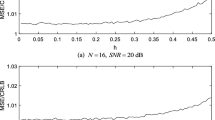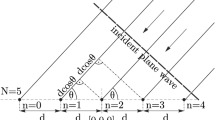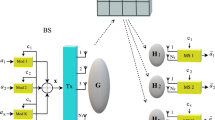Abstract
In this article, timing synchronization in OFDM is attained with the help of Zadoff–Chu sequence as a training symbol. An algorithm based on the cross-correlation property of fractional Fourier transform (FRFT) is proposed to generate a new timing metric. In this algorithm, cross correlation of received signal and Z–Chu sequence is taken at the receiver side in FRFT domain. The mathematical analysis of proposed estimator has been done and the variance of timing metric is obtained under the effect of AWGN channel. The simulation result shows that the variance of timing metric decreases as signal to noise ratio increases. The mean and MSE of the timing offset is simulated under HYPERLAN indoor channel (type-A). The proposed estimation method has been compared with existing methods and established as a better method to combat timing offset.









Similar content being viewed by others
References
Prasad, R., & Hara, S. (2003). Multicarrier techniques for 4G mobile communications. Boston: Universal Personal Communications.
Joshi, H. D., & Saxena, R. (2013). OFDM and its major concerns: A study with way out. IETE Journal of Education, 54(1), 26–49.
Schmidl, T. M., & Cox, D. C. (1997). Robust frequency and timing synchronization for OFDM. IEEE Transactions on Communications, 45(12), 1613–1621.
Park, B., Cheon, H., Kang, C., & Hong, D. (2003). A novel timing estimation method for OFDM systems. IEEE Communication Letters, 7(5), 239–241.
Shi, K., & Serpedin, E. (2004). Coarse frame and carrier synchronization of OFDM systems: a new metric and comparison. IEEE Transactions on Wireless Communications, 3(4), 1271–1284.
Awoseyila, A. B., Kasparis, C., & Evans, B. G. (2008). Improved preamble-aided timing estimation for OFDM systems. IEEE Communications Letters, 12(11), 825–827.
Sahu, B., Chakrabarti, S., & Maskara, S. L. (2010). A new timing synchronization metric for OFDM based WLAN systems. Wireless Personal Communications, 52(4), 829–840.
Singh, A. K., & Saxena, R. (2011). Correlation theorem for fractional Fourier transform. International Journal of Signal Processing, Image Processing and Pattern Recognition, 4(2), 31–40.
Kumari, S., Kr, S., Rai, A. Kumar, Joshi, H. D., Singh, A. K., & Saxena, R. (2013). Exact BER analysis of FRFT–OFDM system over frequency selective rayleigh fading channel with CFO. Electronics Letters, 49(20), 1299–1301.
Gul, M., Lee, S. & Ma, X. (2012). Robust synchronization for OFDM employing Zadoff–Chu sequence. In Proceedings of 46th CISS (pp. 1–6) doi: 10.1109/CISS.2012.6310837.
Tao, R., Li, X. M., & Wang, Y. (2009). Time delay estimation of chirp signals in the fractional Fourier domain. IEEE Transactions on Signal Processing, 57(7), 2852–2855.
Pei, S. C., & Ding, J. J. (2000). Closed-form discrete fractional and affine Fourier transform. IEEE Transactions on Signal Processing, 48(5), 1338–1353.
Singh, A. K., & Saxena, R. (2012). On convolution and product theorems for FRFT. Wireless Personal Communications, 65(1), 189–201.
Singh, A. K., & Saxena, R. (2011). Recent developments in FRFT, DFRFT with their applications in signal and image processing. Recent Patents on Engineering, 5(2), 113–138.
Papoulis, (1965). Probability, Random Variables and Stochastic Processes. New York: McGraw-Hill.
Walpole, R., & Myers, R. (1985). Probability and Statistics for Engineers and Scientists. New York: Macmillan.
Prasad, R., & Van Nee, R. (2000). OFDM for Wireless Multimedia Communications. Boston: Universal Personal Communications.
Channel Models for HIPERLAN/2 in Different Indoor Scenarios (1998), ETSI BRAN 3ERI085B.
Author information
Authors and Affiliations
Corresponding author
Appendix 1
Appendix 1
From Sect. 5, the mean square error of the proposed timing metric is calculated in terms of \(I_{1} , I_{2} , I_{3}\) and \(I_{4}\) using formulae \(Var(XY) = E(X)^{2} E(Y)^{2} - \left( {E(X)} \right)^{2} \left( {E(Y)} \right)^{2}\) as given in (13) where \(I_{1}\) is considered as fourth moment of the received signal in FRFT domain denoted by (14). After expanding (14) into (15), the equation can be re-written as
where part A is the fourth moment of transmitted signal, part B is the fourth moment of AWGN noise and part C is the expectation of product of these two independent terms.
The fourth moment of transmitted signal can be calculated as follows
The above equation can be written after calculating the value of \(\tilde{X}_{ \propto } (u)\) as given below. According to the modulation property defined in FRFT, if a signal is delayed by τ, then its FRFT can be calculated as
where \(B_{ \propto } = exp\left[ {{\text{i}}\tau^{2} \sin \propto \cos \propto /2 - {\text{i}}u\tau \sin \propto } \right]\) and \(\tilde{X}_{ \propto } (u)\) is the FRFT of delayed signal. Using the formula for the calculation of FRFT given in [11], the above equation can be written as
where \(A_{ \propto } = \sqrt {1/2\pi \sin \propto }\) and \(x(t)\) is the transmitted chirp signal given in (1). After substituting the value of \(x(t)\) in above equation, it can be re-written as
As given in Tao et al. [11], the magnitude of FRFT is concentrated maximally at \(u = \tau \cos \propto\) according to (26). Thus using the relation given in (4), the above equation is reduced into following expression
Substitute the value of \(B_{ \propto }\) in above equation, we get
Assume unity time interval (T = 1)
Substitute the value of \(\tilde{X}_{ \propto } (u)\) in \(E[|\tilde{X}_{ \propto } (u)|^{4} ]\), we can determine the fourth moment of transmitted delayed signal. Thus (25) reduces into following equation
In part B, the fourth moment of AWGN noise is calculated using formula \(E[X^{P} ] = \sigma^{P} (P - 1)!!\) if p is even. For this we need to calculate the second moment of noise signal. After solving the second moment and some mathematical manipulation, the value of \(E[|W_{ \propto } (u)|^{2} ]\) comes out to be [11]
Using above equation, we can calculate the value of \(E[|W_{ \propto } (u)|^{4} ]\) using given formula.
Part C can be calculated by taking expectation of their individual terms as follows
The value of \(E[|\tilde{X}_{ \propto } (u)|^{2} ]\) can be calculated in the same way as in (32) and using (33), we can re-write the above equation as
Substitute (32), (33) and (36) into (24), we get
Similarly \(I_{2}\) represents the fourth moment of transmitted signal and using (32), it can be expressed as
\(I_{3}\) represents the square of second moment of received signal and can be written as
Expanding (39) into following expression
Using (36), (40) further reduces into
and \(I_{4}\) represents the square of second moment of transmitted signal and it can be written as
Rights and permissions
About this article
Cite this article
Kaushal, Y., Joshi, H.D., Singh, A.K. et al. Zadoff–Chu Sequence Based Timing Offset Estimation for OFDM Systems. Wireless Pers Commun 98, 2657–2671 (2018). https://doi.org/10.1007/s11277-017-4993-6
Published:
Issue Date:
DOI: https://doi.org/10.1007/s11277-017-4993-6




